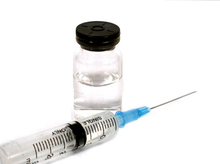April Knudson, DVM, is an equine specialist with Merial Veterinary Services. She has a special interest in equine gastrointestinal health, infectious disease and lameness. She holds a doctor of veterinary medicine from the University of California-Davis. Below, she answers a question about Potomac horse fever.
Q. I’ve never heard of a case of Potomac horse fever in my area. Should I vaccinate my horse against it?

Consult your vet about vaccinations
Potomac horse fever is most common near creeks and rivers and likely caused when horses ingest infected aquatic insects such as damselflies, caddisflies and mayflies.
A. The best way to determine whether or not you should vaccinate your horse against Potomac horse fever or PHF, is to consult with your veterinarian. He or she will have the latest information about whether or not there have been any cases identified around the country and help you assess whether or not your horse could be at risk.
This disease is most commonly found near creeks and rivers and likely caused when horses ingest infected aquatic insects such as damselflies, caddisflies and mayflies. Although named Potomac horse fever because the initial 1979 outbreak occurred near the Potomac River in Maryland, the disease has since been identified in 43 states, three Canadian provinces, parts of South America, the Netherlands and France. Multiple cases in the United States were confirmed by the University of Kentucky Veterinary Diagnostic Laboratory as recently as last summer.
In determining your horse’s possible exposure to PHF, you and your veterinarian should consider the horse’s immediate surroundings and the local projections for this year’s aquatic insect population. You’ll also want to consider the conditions in any areas you might be traveling to during the peak PHF season, which is July, August and September.
PHF can have serious complications, so the decision about whether or not to vaccinate is an important one. The fatality rate in untreated cases can be up to 30 percent. Another devastating effect of PHF is the possible development of laminitis, which occurs in up to 40 percent of affected horses.
Because the disease is difficult to diagnose and has clinical signs that are subtle and mimic other diseases, early detection is key to potential recovery. Signs at the disease’s onset include fever ranging from 102 - 107°F, decreased intestinal sounds and diarrhea. As the disease progresses, some horses suffer from toxemia and dehydration.
Should you and your veterinarian determine PHF could pose a threat to the health of your horse, vaccination is the only way to help provide protection. Merial’s POTOMAVACTM vaccine has been proven to help protect horses against the most serious side effects of PHF, including death. It is also proven safe for horses as young as 3 months of age.
It is also important for horse owners to be aware of potential disease threats in their communities and any areas they may be traveling to. “Outbreak Alert,” a free program created by Merial, helps horse owners protect the health of their horses, not just in their own backyard, but also around the country.
As reports of influenza, WNV, PHF, Rabies, EEE/WEE and EHV-1 are identified and confirmed, they are posted on the outbreak-alert.com website map. As an additional service, horse owners and veterinarians who have signed up for the service and live within a certain radius of the report receive a text or e-mail notification. To sign up for the service, visit outbreak-alert.com.
Read more about Potomac horse fever
